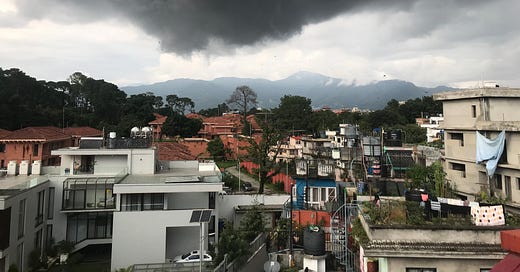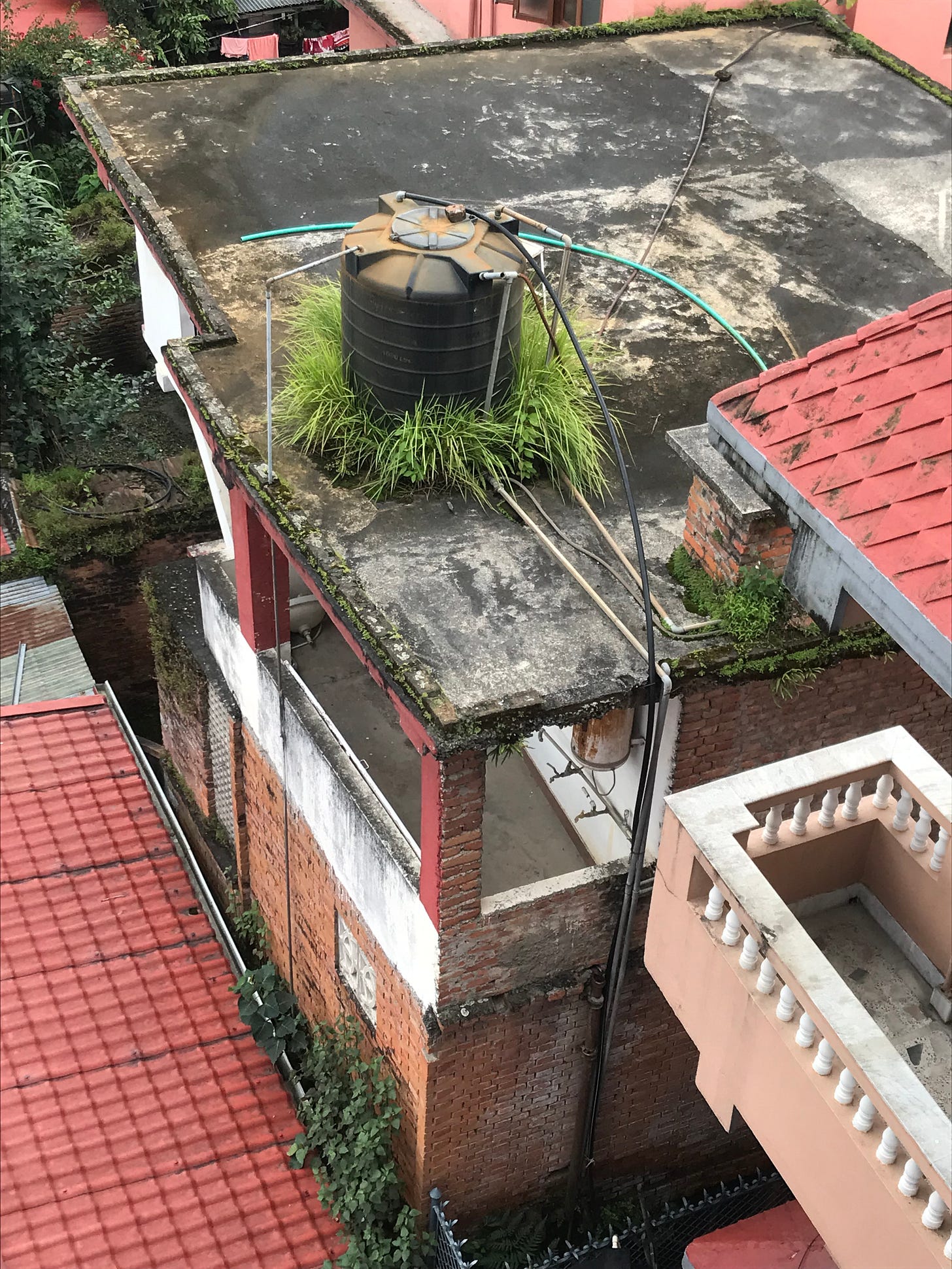Last Wednesday night, not long after I hit publish on my first post, it began to pour: a proper, heavy torrent. It rained in the days that followed, too. This monsoon has felt different, though I’ve just remembered that when I tell my sister X is different in Nepal this year, she often asks “Didn’t you tell me that last year?” so really, who knows.
But this year rain and wild storms came earlier than usual, and when monsoon did come in earnest, it felt more mellow, less violent somehow. And for the last few weeks, there’s been more sun than not, and it was starting to feel like the rainy season was, for all intents and purposes, pretty much over.
That’s why it’s felt like this past week was the rain gods shaking their fists and saying “We’re not through yet!”
On Friday I was on the upper roof watching the sky to the north get darker and darker while behind me the sun still shone in a blue sky. Off to the east, the sound of rain, moving closer, and a double rainbow before the storm won the battle of the skies. Up there with the wind going wild and just a slight spray of rain, I thought, this is the last gasp.
I’m really going to miss it.

**
I love that Kathmandu has distinct seasons, each with something I look forward to. The first monsoon I spent here, however, I did not love it. I wasn’t used to months of rain, and ignorantly tried to carry on as usual, keeping appointments even if it meant driving into a rain storm when everyone else, wisely, had pulled over waiting for the worst to pass.
Kathmandu’s famous micro-climates (quoting a friend, as I know no better way to put it) mean that it can literally be dry where you are and bucketing down just meters ahead of you. In fact I can remember exactly where I was—on the road that flanks the west side of the former royal palace, now museum—when I first saw this phenomenon in action, while riding a bicycle. I looked ahead to my destination, and saw the rain. As I said, I was pretty dumb. There was an appointment! I had somewhere to be!
I drove right into it.
Five minutes later, instead of keeping my appointment, I was ringing my clothes out in the sink of a hotel restroom.
The key seems to be going with the flow. I’m still a stickler for punctuality, but I’ve also learned that “I’ll be a little late, it’s pouring here,” is a perfectly acceptable excuse, both to give and receive, in a city where a majority of people get around on two wheels.
**
More people should visit Nepal during this time of year. True, a view of the Himalaya is not guaranteed and land travel can be treacherous, but everything is green and growing riotously and the air feels fresh-washed in a way that is exclusive to the monsoon months. The plants on my balcony seem to be genuinely delighted—even the succulents—and I see the same vibrancy and wildness in everything growing everywhere, whether a giant tree or a weed on a rooftop.
There is—of course—another side to all this that is impossible to gloss over and romanticize: rains can cause a lot of suffering at this time of year, too. There have been years with washed out roads and deadly vehicle accidents, as well as serious landslides in the hills and flooding in the southern Terai region. The rains, so essential for the farmers—rice planting season in particular—are a double-edged sword, a force essential to so much and yet impossible to control.
Dengue fever cases have also risen stratospherically in recent weeks; while it wasn’t unheard of, it used to be relatively rare. Now, according to public health experts, it’s become endemic, and this year many of my friends have gotten it. Dengue-carrying mosquitoes are active during the day, so there are diffusers on all day instead of just at night now, and we are coating ourselves in insect repellent when we leave our homes. Lalitpur has been worst hit, but cases are rising here in Kathmandu, too. And while it’s not a disease specific to this time of year, water water everywhere certainly gives those little flyers a lot more places to breed, not least because inconsistent (or occasionally non-existent) water supplies mean that people understandably tend to save and store water.
**
The first chilly nip of autumn raised its head about two weeks ago, but it was fleeting, and it was only on Monday that I really felt it was nearly here: a glorious sun-wind day, so different in feel from the blazing summer sun of the last few months and the wild winds that make all your doors slam and presage the coming of a storm.
It reminded me of a children’s book I read years ago, a retelling of a local legend. Birds and Kathmandu residents were in conflict: people loved to fly kites, and it was annoying the avian community. The then-king brokered an agreement that kites would only be flown in the autumn months, leaving the sky to the birds the rest of the year. It makes me smile every time I remember it, and I’m waiting for my first glimpse of paper and bamboo fluttering on the breeze high above rooftops.
**
Thank you to all of you who have subscribed and sent kind words about my first post. Perhaps I should have prefaced last week’s essay by saying that it had been in the works for a long time—over a year. This newsletter is me challenging myself to write, consistently, each week, and you may find some posts a little trivial, and certainly less polished. I hope you enjoy them anyway and thank you for joining me on the journey.





Mad about having missed monsoon in ktm this year, but reading your article was very cathartic
Micro climate is my takeaway, although I am loving how I am living my home through your posts. I am grateful is all I can conjure. I hope you keep writing.